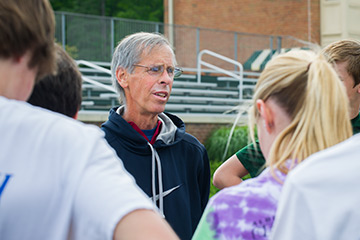The ultimate gift
A beloved coach receives a liver, just in the nick of time

Shortly after Election Day in 2012, Weldon Bradshaw, a teacher and cross-country coach at Collegiate School in Richmond, Va., learned that he would be dead within a week unless he received a liver transplant.
Bradshaw, 65, was suffering from primary sclerosing cholangitis, an autoimmune disease in which the body attacks the liver, inflaming the bile ducts, eventually causing liver failure. The cause of PSC is unknown.
VCU Medical Center doctors diagnosed his condition in 2009, but it wasn't until summer 2012 that his health took a turn for the worse.
“PSC causes numerous side effects, including jaundice and fatigue,” said Bradshaw, a runner for more than 30 years until his hip gave out. “Some days it was like walking through deep mud; I felt like I couldn't get anywhere.”
With his health declining, Bradshaw was placed on the transplant list the first week in October.
“On Wednesday, Oct. 17, we had a home cross-country meet and I could barely lift my head,” he said. “That Sunday, I told my wife, 'It's time.'”
The wait
Bradshaw underwent six days of tests at the VCU Medical Center and was admitted to the intensive care unit 10 days later.
Shortly afterward, his doctor told him he had until the end of the week to receive a liver, based on his MELD score. The MELD, or Model for End-Stage Liver Disease, determines how urgently a patient needs a liver transplant within the next three months. The calculation typically ranges from 6 (less ill) to 40 (gravely ill). Bradshaw's score was near 50.
“I had confidence a donor liver would come through,” Bradshaw said. “Then the days started to pass, and no liver.”
On day six, in the wee hours of the morning, Bradshaw learned he would receive a “pristine” donor liver from an 84-year-old deceased woman in Wilmington, N.C., and underwent surgery several hours later.
A lifesaving liver
During the seven-hour procedure, the VCU surgical team used new techniques, some developed at the Hume-Lee Transplant Center, to sustain the donated liver and stabilize Bradshaw's other organs that had begun shutting down.
At the time, the VCU Medical Center was the only facility in the UNOS region able to transplant an organ more than 10 years older than the recipient.
“A sequence of events happened that enabled me to survive, and they happened in the nick of time,” Bradshaw said. “Part of it was me being in the right hospital with the right doctor. I don't know how much of a risk it was to put this liver in me, but there was no second choice.”
Six months later, Bradshaw is continuing to recover, gain strength and reflect on the experience.
“I see this is as a God-given gift that was challenging me to be who I want to be,” Bradshaw said. “When I'm out at the track, I've always told the kids, 'When you think there's nothing left, you can always find something deep inside you that will get you that extra few steps.'
“Now that has a different meaning because of the experience I've had.”
\
